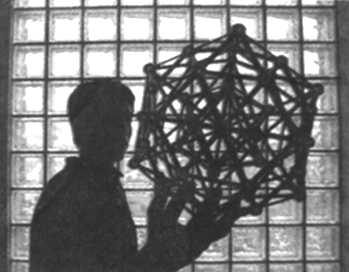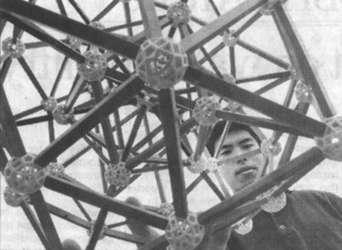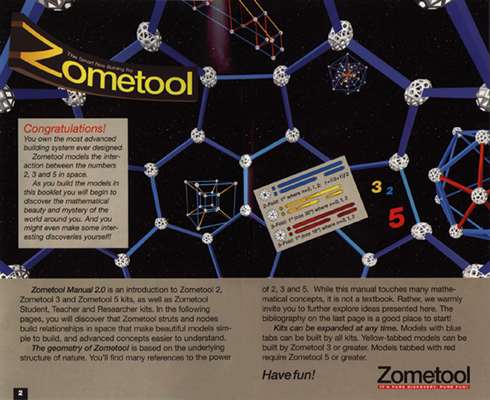
Math whiz gets to show up his
elders
The San Diego Union - Tribune. San Diego, California.
Aug 21, 2001; Jeff Ristine, Staff Writer
Abstract:
"What [Kevin Chan] did should be regarded as surprising,"
said Robert Leary, a senior staff scientist at the
center and Chan's mentor. Resources to do such work
tend to be limited, Leary said, and while others previously
"found an answer for 78 (atoms), Kevin found a better
answer."
These nanoscaled atomic clusters are too small to
be directly observed. But using supercomputers, Chan
eventually simulated a double icosahedron -- two 20-sided
clusters of atoms stuck to one another at the side
like soap bubbles containing a combined total of 78
neutral atoms.
| Copyright
SAN DIEGO UNION TRIBUNE PUBLISHING COMPANY Aug
21, 2001 |
Kevin Chan found an atomic needle in a mathematical
haystack.
During an internship at the San Diego Supercomputer
Center, the Del Mar resident and Harvard University
sophomore amazed the pros this summer with his work
involving clusters of atoms and the energies they
contain.
After more than 20,000 hours of computer processing
time, Chan, 18, discovered a hypothetical arrangement
for 78 atoms that seems to represent an ideal in nature:
an energy minimum.
To a specialized group of scientists and mathematicians,
it was a big deal. Chan found a new energy minimum
for one particular atomic cluster and thus added one
small bit of information to the field.
"What Kevin did should be regarded as surprising,"
said Robert Leary, a senior staff scientist at the
center and Chan's mentor. Resources to do such work
tend to be limited, Leary said, and while others previously
"found an answer for 78 (atoms), Kevin found a better
answer."
 |
Kevin Chan, with a model of an icosahedron,
actually two, one inside the other. He solved
a computational problem involving atoms forming
the structure. (Photo:
Jim Baird / Union-Tribune)
|
Chan used a mathematical strategy developed by Leary
to make his discovery just a few weeks into his internship.
"Dr. Leary had mentioned that it was possible we
would find some new structures, but this was kind
of unexplored territory," said Chan, a graduate of
The Bishop's School in La Jolla.
Esoteric as it may appear, however, the chore holds
at least passing relevance -- get this -- to mad cow
disease.
What?!
Mad cow disease, a human equivalent called variant
Creutzfeldt- Jakob disease and other deadly neurodegenerative
conditions all involve a misfolded, infectious form
of protein called the prion.
Good prions and bad ones are "folded" differently,
and current thinking holds the difference has something
to do with the geometric configuration of their atoms.
There are good shapes and bad ones; infectious prions
are associated with the bad ones, and they have different
energies.
In doing mathematical work on atomic clusters, scientists
hope to gain insights on how proteins get to their
lowest energy state.
Which brings us to Chan's work, called global optimization.
Chan, who is majoring in math, was participating
in Research Experiences for Undergraduates, a National
Science Foundation program to give students a chance
to see what research is like and work on important
projects in their field.
The San Diego Supercomputer Center, a national laboratory
for computational science and engineering at UCSD,
welcomed him for 10 weeks.
Chan said he hadn't worked on atomic clusters before,
but knew something about global optimization and enjoyed
studying symmetry.

|
Kevin Chan was "surprised and excited" when
he realized he had made a research breakthrough.
"When you're an undergraduate, you're just kind
of learning what's going on and how to conduct
research," he said. (Photo: Jim Baird / Union-Tribune)
|
Leary introduced him to a method he had developed
called "basin- hopping," which methodically jumps
from one geometric configuration to another in search
of lower and lower energies, or "valleys" as Leary
calls them. The very bottom is the lowest energy configuration
preferred by nature for that cluster.
"There are a lot of valleys," said Leary. "If you
wanted to put a number (on it), it would be a 1 with
30 zeros after it."
Leary likens the forces between atoms to the tension
of a spring, which can be pulled or stretched. These
forces hold the cluster together in a particular geometry
that represents the lowest energy configuration.
These nanoscaled atomic clusters are too small to
be directly observed. But using supercomputers, Chan
eventually simulated a double icosahedron -- two 20-sided
clusters of atoms stuck to one another at the side
like soap bubbles containing a combined total of 78
neutral atoms.
Chan and Leary threw as much computational power
at the cluster simulations as they could muster, and
even used the center's IBM Blue Horizon -- one of
the most powerful computers in the academic world
- - for part of their work.
"At one point we were using 256 processors at a
time," Leary said.
Previous efforts by more experienced scientists
to accomplish the same goal had arrived at a much
different shape. Chan's is lower in energy and therefore
appears to come closer to representing the true, physical
form of one particular class of 78-atom clusters in
nature.
Among other reasons, scientists want to know the
shapes of these clusters because their properties
tie into bigger concerns in nature.
"We believe that the algorithms that we're using
on the clusters can be used on proteins," said Leary.
Chan said the new structure "popped up unexpectedly"
and he was "surprised and excited" when he realized
it was something that hadn't been found before.
"When you're an undergraduate, you're just kind
of learning what's going on and how to conduct research,"
he said. "Sometimes you don't get to go into the real
interesting stuff that makes a real contribution to
science. I was happy to be able to do that."
[Illustration]
2 PICS; Caption:
- Kevin Chan, with a model
of an icosahedron, actually two, one inside the
other. He solved a computational problem involving
atoms forming the structure.
- Kevin Chan was "surprised
and excited" when he realized he had made a research
breakthrough. "When you're an undergraduate, you're
just kind of learning what's going on and how to
conduct research," he said.
(B-5); Credit: 1,2. Jim Baird
/ Union-Tribune

|





